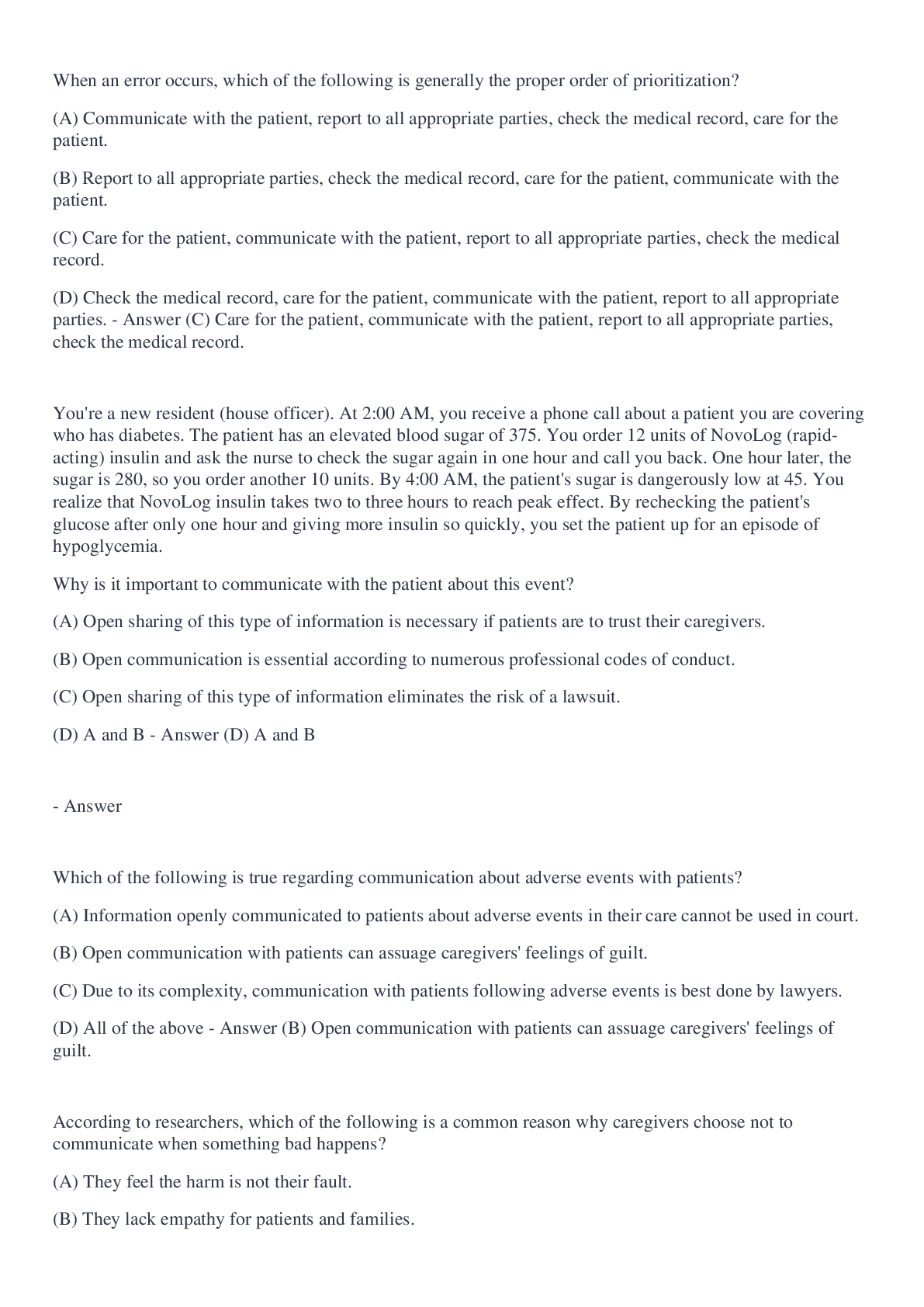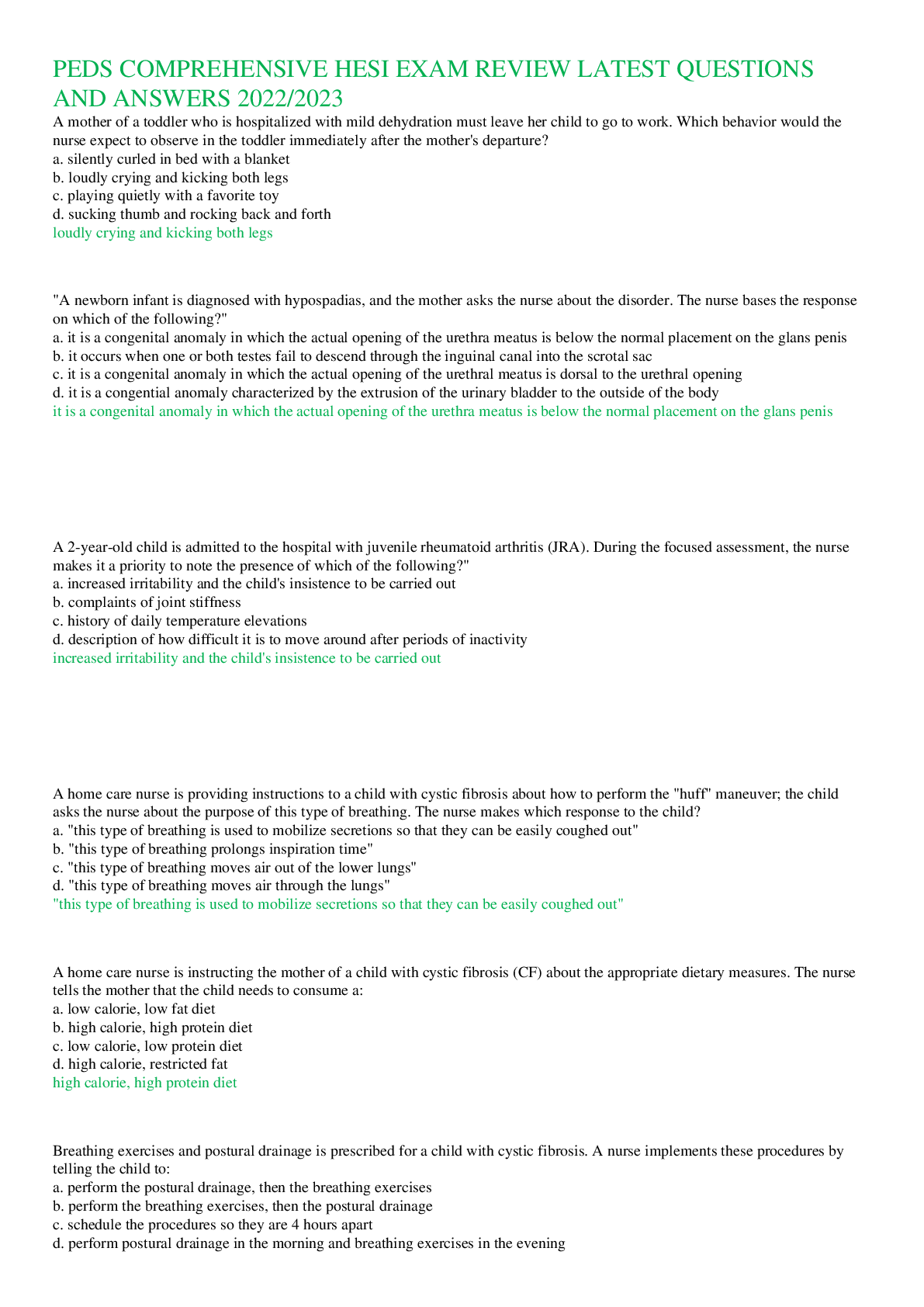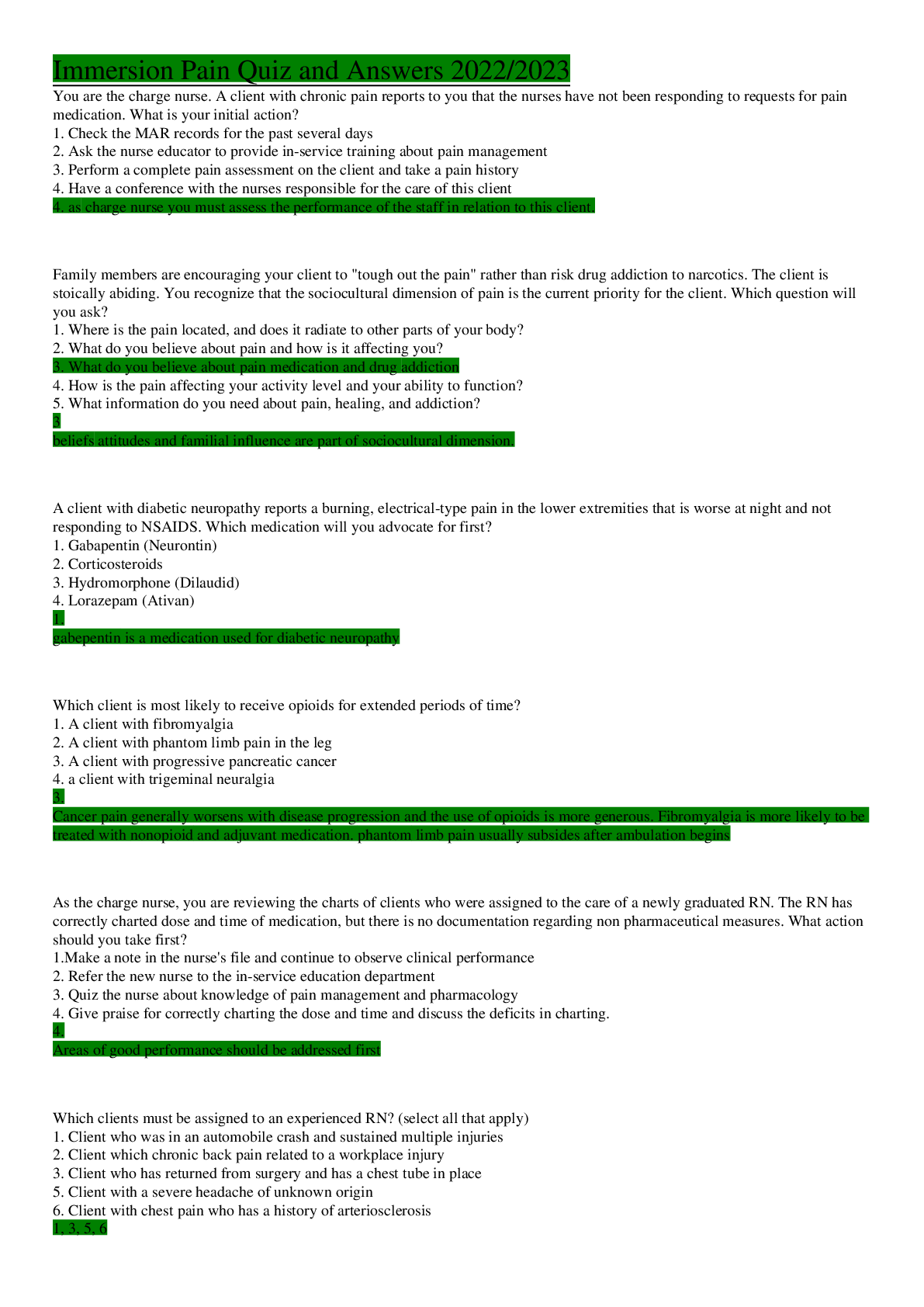IHI PS 105 QUESTIONS AND ANSWERS 2022/2023
Document Content and Description Below
When an error occurs, which of the following is generally the proper order of prioritization? (A) Communicate with the patient, report to all appropriate parties, check the medical record, care for t... he patient. (B) Report to all appropriate parties, check the medical record, care for the patient, communicate with the patient. (C) Care for the patient, communicate with the patient, report to all appropriate parties, check the medical record. (D) Check the medical record, care for the patient, communicate with the patient, report to all appropriate parties. (C) Care for the patient, communicate with the patient, report to all appropriate parties, check the medical record. You're a new resident (house officer). At 2:00 AM, you receive a phone call about a patient you are covering who has diabetes. The patient has an elevated blood sugar of 375. You order 12 units of NovoLog (rapid-acting) insulin and ask the nurse to check the sugar again in one hour and call you back. One hour later, the sugar is 280, so you order another 10 units. By 4:00 AM, the patient's sugar is dangerously low at 45. You realize that NovoLog insulin takes two to three hours to reach peak effect. By rechecking the patient's glucose after only one hour and giving more insulin so quickly, you set the patient up for an episode of hypoglycemia. Why is it important to communicate with the patient about this event? (A) Open sharing of this type of information is necessary if patients are to trust their caregivers. (B) Open communication is essential according to numerous professional codes of conduct. (C) Open sharing of this type of information eliminates the risk of a lawsuit. (D) A and B (D) A and B ... ... Which of the following is true regarding communication about adverse events with patients? (A) Information openly communicated to patients about adverse events in their care cannot be used in court. (B) Open communication with patients can assuage caregivers' feelings of guilt. (C) Due to its complexity, communication with patients following adverse events is best done by lawyers. (D) All of the above (B) Open communication with patients can assuage caregivers' feelings of guilt. According to researchers, which of the following is a common reason why caregivers choose not to communicate when something bad happens? (A) They feel the harm is not their fault. (B) They lack empathy for patients and families. (C) They fear disapproval. (D) All of the above (C) They fear disapproval. If you are responsible for the initial communication with the patient about the error, which of the following should you be sure to do? (A) Speak clearly and directly (B) Disguise any feelings of concern or remorse (C) Explain the exact cause of the error (D) All of the above (A) Speak clearly and directly Which of the following is a common fear clinicians experience after errors? (A) Fear of job loss (B) Fear of anger from the patient and/or authority figures (C) Fear of negative publicity (D) All of the above (D) All of the above According to a survey in The Lancet, when patients and families pursue lawsuits against their providers, which of the following is one of the things they want most? (A) Publicity (B) Increased public reporting of errors (C) Tougher laws (D) An explanation D) An explanation You're a new resident (house officer). At 2:00 AM, you receive a phone call about a patient you are covering who has diabetes. The patient has an elevated blood sugar of 375. You order 12 units of NovoLog (rapid-acting) insulin and ask the nurse to check the sugar again in one hour and call you back. One hour later, the sugar is 280, so you order another 10 units. By 4:00 AM, the patient's sugar is dangerously low at 45. You realize that NovoLog insulin takes two to three hours to reach peak effect. By rechecking the patient's glucose after only one hour and giving more insulin so quickly, you set the patient up for an episode of hypoglycemia. Based on the common reasons why caregivers choose not to communicate when something bad happens, why might it be difficult for you to discuss what happened with this patient? (A) A lack of time (B) A lack of empathy (C) A need to preserve a sense of self (D) None of the above (C) A need to preserve a sense of self Who of the following people might be appropriate to include in an initial conversation with a patient about a medical error in his or her care? (A) A risk manager (B) The patient's physician (C) The patient's family (D) All of the above (D) All of the above You sit down with a patient to break the bad news about a lapse in follow-up on a lung mass detected in a recent chest x-ray. Which of the following is important information to include in this first discussion? (A) Your intention to prevent this type of error from happening again (B) The punitive action that will be taken against the person at fault (C) Why this error is not anyone's fault (D) A and B (A) Your intention to prevent this type of error from happening again When an error occurs, which of the following is generally the proper order of prioritization? (A) Communicate with the patient, report to all appropriate parties, check the medical record, care for the patient. (B) Report to all appropriate parties, check the medical record, care for the patient, communicate with the patient. (C) Care for the patient, communicate with the patient, report to all appropriate parties, check the medical record. (D) Check the medical record, care for the patient, communicate with the patient, report to all appropriate parties. (C) Care for the patient, communicate with the patient, report to all appropriate parties, check the medical record. Janice is a nurse on the orthopedics unit. This night, she is caring for five patients, as well as a new admission from the emergency department. While juggling patient care, she calls the on-call resident (house officer) about Mrs. Bernardo, who is in significant pain from a fractured hip. Janice hastily writes down the morphine order from the resident and is then called away when another patient falls out of bed. An hour later, she realizes, to her dismay, that she has not yet given Mrs. Bernardo her pain medication. When she rushes into the room, the patient is crying and asking, "Why won't someone help me?" Janice quickly administers the morphine. When discussing the event with Mrs. Bernardo, the most appropriate initial comment would be: (A) "How is your pain?" (B) "Although it took an hour to get the pain medication, we remain committed to making sure you receive excellent care." (C) "I apologize for the delay in your morphine." (D) "Pain medication can be very tricky, so we are always careful not to give too much, too quickly. Sometimes that means that it takes a while to get your pain under control." (A) "How is your pain?" Why is it important for Janice to apologize to Mrs. Bernardo for the delay in her pain medication? (A) It is not necessary to apologize in this case. (B) An apology is needed to maintain provider-patient trust. (C) All institutions require an apology. (D) An apology will prevent the patient relations department from becoming involved. (B) An apology is needed to maintain provider-patient trust. "Mrs. Bernardo, there was a delay in you receiving your pain medication that should not have happened. I am very sorry that you had unnecessary pain. The doctor gave me the order to give you a dose of morphine. However, I was caring for another patient who had fallen, and I got distracted and did not give you the medication as quickly as I should have. Again, I just want you to know how sorry I am that this happened." Which one of Aaron Lazare's four components of an apology is missing in Janice's apology? (A) Acknowledgment (B) Explanation (C) Expression of remorse or shame (D) Reparation (D) Reparation When giving an explanation for why an adverse event happened, it can sometimes be a good idea to: (A) Give whatever explanation you have at the time, even if some of the information is speculative. (B) Explain how the patient could have helped prevent the error. (C) Say something like, "There is just no excuse for what happened." (D) All of the above (C) Say something like, "There is just no excuse for what happened." "Mrs. Bernardo, there was a delay in you receiving your pain medication that should not have happened. I am very sorry that you had unnecessary pain. In the future, someone will check up on you more frequently overnight. Again, I just want you to know how sorry I am that this happened." Which one of Aaron Lazare's four components of an apology is missing in Janice's apology? (A) Acknowledgment (B) Explanation (C) Expression of remorse or shame (D) Reparation (B) Explanation When giving an explanation for why an event happened, it is always important to: (A) Be factual. (B) Have documents to back up your explanation. (C) Go over the explanation with a risk manager prior to your discussion with the patient. (D) All of the above (A) Be factual. When an adverse event befalls a patient, who are the "second victims" according to Dr. Albert Wu? (A) The patient's family (B) The caregivers involved in the error (C) The risk managers who become involved in the error (D) Other patients who might experience the same error in the future (B) The caregivers involved in the error As the Health Unit Coordinator (HUC), it is your job to enter orders from providers into the computer system. Direct provider order entry is planned for your hospital next year when the electronic health record is implemented. You check charts every couple of hours for new orders, unless the providers "flag" the chart by turning a dial on its side to red — in which case, you check the chart right away. On a particularly busy day, you see a chart tucked in a corner and realize that you have not looked at it in at least six hours. Worse, you check the order dial and see that it's partly red. On the order sheet are orders for "STAT" pain medications and antibiotics for a new patient. You quickly input the orders, your heart pounding. Three hours later, the patient is transferred to the intensive care unit with worsening sepsis (infection). When your supervisor informs you about what happened, you go numb thinking about those six hours and the cost to the patient. What should ideally happen? (A) She should speak calmly with you about what happened and how you're feeling about it. (B) She should remind you that these errors happen to everyone and they're no big deal. (C) She should encourage you to stay busy at work, to help you move past the incident. (D) She should suspend you immediately, so that you have a couple of weeks to process what happened and learn from your mistake (A) She should speak calmly with you about what happened and how you're feeling about it. ... ... As the Health Unit Coordinator (HUC), it is your job to enter orders from providers into the computer system. Direct provider order entry is planned for your hospital next year when the electronic health record is implemented. You check charts every couple of hours for new orders, unless the providers "flag" the chart by turning a dial on its side to red — in which case, you check the chart right away. On a particularly busy day, you see a chart tucked in a corner and realize that you have not looked at it in at least six hours. Worse, you check the order dial and see that it's partly red. On the order sheet are orders for "STAT" pain medications and antibiotics for a new patient. You quickly input the orders, your heart pounding. Three hours later, the patient is transferred to the intensive care unit with worsening sepsis (infection). Why is it important for the organization to offer you help and support at this time? (A) The organization is legally obligated to do so. (B) Offering support helps prevent depression or decreased job satisfaction. (C) Offering support decreases the institution's legal risk following the error. (D) Offering support decreases the risk of future errors. (B) Offering support helps prevent depression or decreased job satisfaction. As the Health Unit Coordinator (HUC), it is your job to enter orders from providers into the computer system. Direct provider order entry is planned for your hospital next year when the electronic health record is implemented. You check charts every couple of hours for new orders, unless the providers "flag" the chart by turning a dial on its side to red — in which case, you check the chart right away. On a particularly busy day, you see a chart tucked in a corner and realize that you have not looked at it in at least six hours. Worse, you check the order dial and see that it's partly red. On the order sheet are orders for "STAT" pain medications and antibiotics for a new patient. You quickly input the orders, your heart pounding. Three hours later, the patient is transferred to the intensive care unit with worsening sepsis (infection). Based on what you know about the incident, which of the following statements seems to be a fundamental attribution error? (A) "Someone almost died because things were so busy yesterday." (B) "The HUC almost killed someone yesterday because she doesn't pay enough attention." (C) "The electronic health record can't come soon enough — the current system almost killed someone yesterday." (D) "I can't believe what an awful situation the HUC ended up in yesterday; someone almost died." (B) "The HUC almost killed someone yesterday because she doesn't pay enough attention." Which of the following is a support mechanism that might be available to caregivers after traumatic events? (A) Care coordination (B) The Employee Assistance Program (C) Ombudsmen (D) The patient relations department (B) The Employee Assistance Program Rumors quickly spread on your unit. The next day you overhear a nurse telling another nurse, "The HUC almost killed someone yesterday with her carelessness." What does this comment exemplify? (A) Natural concern for patient care on the unit (B) James Reason's approach to human error (C) Unified theory of safety (D) Fundamental attribution error (D) Fundamental attribution error According to a study by Scott and colleagues, what is a common type of support caregivers ask for after adverse events? (A) Change of jobs (B) Extended leaves (C) Early identification of suffering (D) A and B (C) Early identification of suffering Why should a RCA be conducted by a team rather than by an individual? (A) Understanding what led to an error requires diverse perspectives. (B) A team helps the RCA move more quickly. (C) Individuals usually are not equipped to complete the intense RCA process on their own. (D) Teams are better able to stand up to the conflict that usually comes about when the results of the RCA are made public. (A) Understanding what led to an error requires diverse perspectives The heart of the RCA process is: (A) Doing a complete and thorough reconstruction of what happened before the event. (B) Defining what should have happened for the patient. (C) Identifying what caused the event. (D) Creating a fishbone diagram. (C) Identifying what caused the event. Prathibha, a 29-year-old woman, is recovering from same-day knee surgery. While in the post-anesthesia care unit (PACU), she unexpectedly goes into acute respiratory failure and requires intubation. Because she is a young, healthy woman with no medical problems and this was a very unexpected outcome, the charge nurse convenes a team to conduct a root cause analysis. As the RCA for this case begins, the team struggles with identification of the root causes of the outcome. They consider the patient's characteristics as well as the work environment. According to Charles Vincent, what other areas should they consider? (A) Team factors, institutional context, and organizational factors (B) Budget, human nature, and organizational factors (C) Team factors, human nature, and PDSA cycles (D) Psychology, PDSA cycles, and management factors (A) Team factors, institutional context, and organizational factors [Show More]
Last updated: 2 years ago
Preview 1 out of 9 pages

Buy this document to get the full access instantly
Instant Download Access after purchase
Buy NowInstant download
We Accept:

Reviews( 0 )
$12.00
Can't find what you want? Try our AI powered Search
Document information
Connected school, study & course
About the document
Uploaded On
Nov 27, 2022
Number of pages
9
Written in
Additional information
This document has been written for:
Uploaded
Nov 27, 2022
Downloads
0
Views
54

























